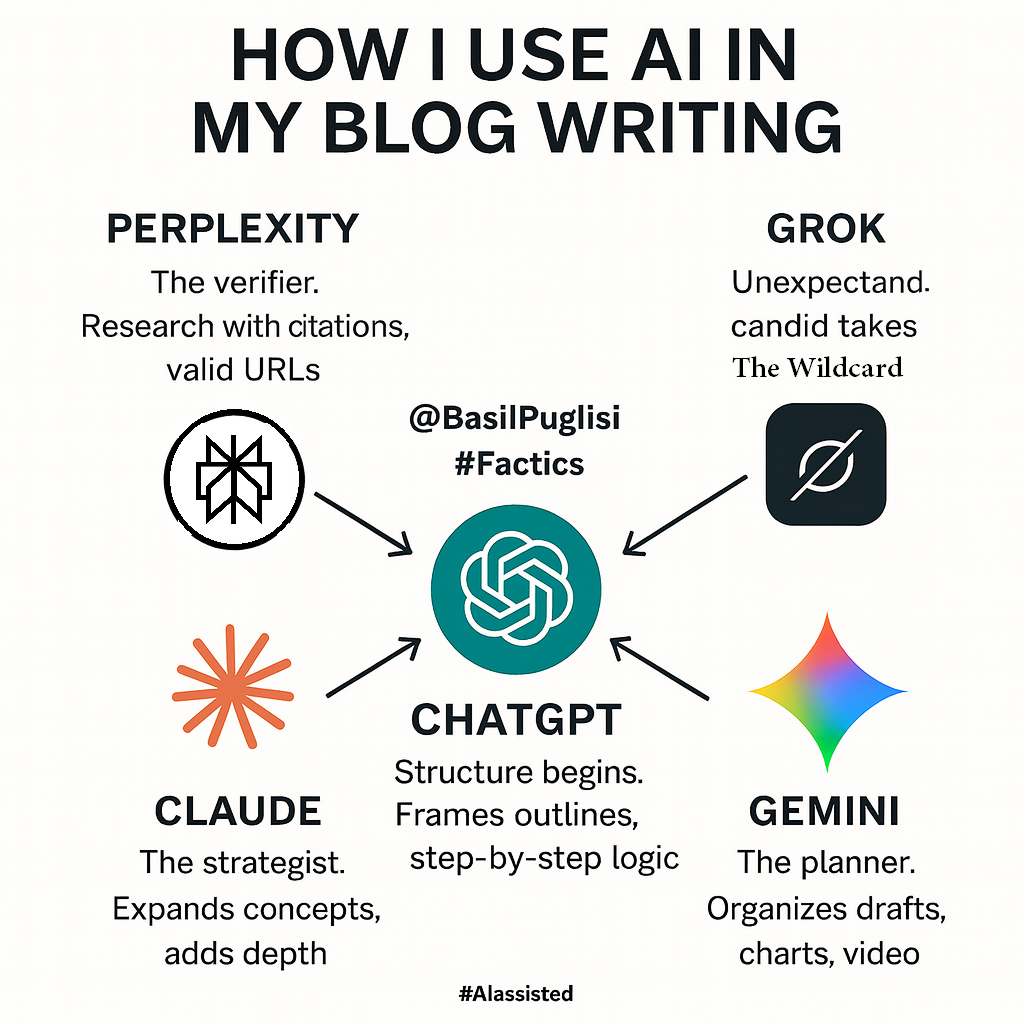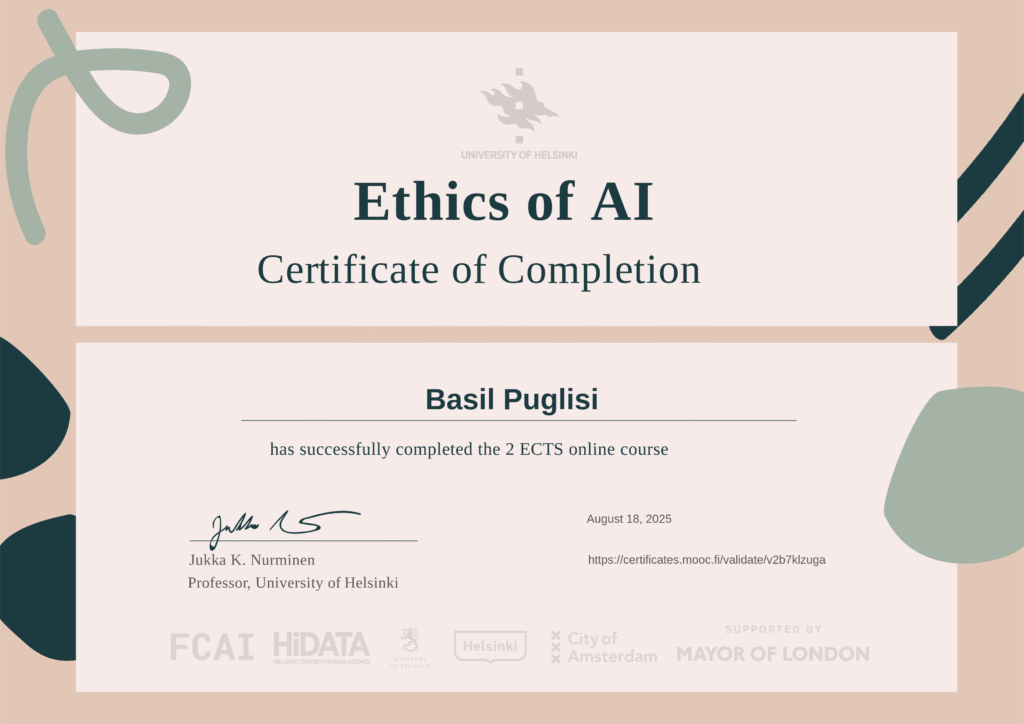These are the current content AIs used on this platform and will be updated as accurately as possible each year. To understand how these AI tools are applied, visit the Content Disclosure page. To learn more about the person behind the AI, visit the About page for @BasilPuglisi.
– All AI Blogs can be found Here – All White Papers can be found Here –

It’s important to distinguish between the two categories of content published here. Both involve human insight, but each serves a different role
#AIassisted (#AIa) — Human-Led Analysis
#AIa content is authored by Basil Puglisi. These are monthly deep-dive reviews of industry trends, informed by AI research but written and synthesized with Basil’s experience and expertise.
Key features of #AIa content:
- Deep Sourcing: More than 20 sources are reviewed to carefully select 9–12 for each piece.
- Factics Method: Connecting data points to actionable tactics.
- Best Practice Spotlights: Real-world case studies from brands and organizations.
- Creative Consulting Concepts: Fictional “What If” scenarios for B2B, B2C, and Non-Profit applications.
- Curated Video Support: Videos, primarily from YouTube, are included to reinforce key insights.
#AIa posts represent the human voice and judgment behind this platform — applying strategy and narrative to the signals AI surfaces.
#AIgenerated (#AIg) — AI-Driven Industry Updates
#AIg content delivers fast-turnaround updates on fundamental shifts in digital marketing. These posts are created through human-led prompts across multiple AI platforms (such as Gemini, Grok, Claude, Perplexity, and the latest models from OpenAI/ChatGPT).
Key features of #AIg content:
- Focused Categories: Monthly coverage of SEO, Social Media, and Workflow (CRM, eCommerce, Lead Generation).
- Multi-Platform Vetting: Every post is generated with input from at least two AI platforms to research, write, and edit.
- Content + Featured Images: Both are AI-produced for consistency and speed.
- Clear Labeling: Each post is tagged #AIgenerated or #AIg in the title and category, ensuring no confusion with Basil’s authored content.
***update August 2025*** the AIs have updated the Disclosure = This blog was written with the assistance of AI research and drafting tools, using only verified sources published on or before July 31, 2025. Human review shaped the final narrative, transitions, and tactical recommendations.
#AIg posts provide the raw updates and signals, which then inform Basil’s end-of-month #AIa synthesis.
***Note: AI Scan i.e. Originality.ai – My Opinion, read here***
At a Glance
| Attribute | #AIassisted (#AIa) | #AIgenerated (#AIg) |
|---|---|---|
| Primary Author | Basil Puglisi (Human Expert) | AI Platforms (Human Guided) |
| Purpose | Expert review, in‑depth analysis, and strategy | Rapid updates on industry changes |
| Topics | Monthly trend synthesis | SEO, Social Media, Workflow |
| Process | Deep research (20+ sources), Factics, human writing | Multi‑AI prompts; content + image production |
| Key Features | Best Practice Spotlights; Creative Consulting Concepts; curated videos | Multi‑platform vetting; labeled #AIg; basis for #AIa |
In short, #AIgenerated delivers the what — fast updates on what just happened — while #AIassisted delivers the so what — Basil’s expert context, strategic application, and human judgment layered on top of that data.
This isn’t just a practice Google would “approve” of; it’s a practice that directly aligns with the future of high-quality, trustworthy web content. – Gemni Pro August 2025
Both forms involve human insight, but #AIgenerated reflects direct AI-driven production under expert guidance, while #AIassisted reflects AI’s supporting role throughout the research and creation process. Read The Ethics of AI A White Paper on Principles, Risks, and Responsibility by Basil Puglisi
AI Tools Disclosure
ChatGPT (GPT‑4)
ChatGPT is a conversational AI developed by OpenAI, currently running on the GPT‑4 architecture. It is designed to generate human‑like responses to text inputs, enabling tasks like answering questions, drafting content, explaining concepts, and simulating dialogue. ChatGPT works by predicting the most likely next word in a sequence based on patterns learned from vast datasets, making it useful for research, writing, brainstorming, and more.
GPT‑4 is a large‑scale transformer‑based language model trained on a mixture of licensed data, data created by human trainers, and publicly available data. It uses self‑attention mechanisms to analyze and generate text, and is fine‑tuned using Reinforcement Learning from Human Feedback (RLHF) to improve output quality and alignment with user intent. GPT‑4 can handle complex reasoning tasks, supports a large context window for longer conversations, and is integrated with tools such as code interpreters, web browsing, and image generation.
Grok
Grok, created by xAI (founded by Elon Musk), is an AI tool designed to help users understand the world through reason and skepticism. It analyzes information and provides clear, honest answers, often with a unique outside perspective on humanity. I use Grok for research and content creation, tagging such content with #AIgenerated.
Grok is built on a transformer‑based architecture with a Mixture‑of‑Experts design, reportedly containing around 1.7 trillion parameters in its latest version, Grok 4. It was trained using reinforcement learning on xAI’s Colossus supercomputer, enabling advanced reasoning and native tool integration. Capabilities include real‑time web search, code generation, and multimodal processing of text and images, with a context window up to 256,000 tokens.
Gemini
Gemini is a family of powerful AI models developed by Google DeepMind, designed to understand and generate text, images, audio, and video. Versions like Gemini 2.5 Pro (advanced reasoning) and Gemini 2.5 Flash (optimized for speed) can respond to complex prompts, generate creative content, summarize information, and assist with coding. Gemini aims to augment human capabilities across diverse tasks.
Gemini models use a transformer architecture with self‑attention mechanisms and are natively multimodal, pre‑trained on diverse datasets of text, images, audio, and video. Training involves supervised fine‑tuning (SFT) and Reinforcement Learning from Human Feedback (RLHF). Advanced capabilities include multimodal reasoning, code generation, and deep research, with seamless integration into Google Workspace for productivity tasks.
Perplexity AI
Perplexity AI is an advanced AI‑powered answer engine developed by Perplexity AI Inc. It combines large language models with real‑time web search to provide concise answers with cited sources. Acting like a conversational search assistant, it helps users discover knowledge and conduct research efficiently.
Perplexity AI uses a Retrieval‑Augmented Generation (RAG) system, combining transformer‑based language models with real‑time retrieval of contextual documents. Its core model, Sonar Large 32K, is fine‑tuned from LLaMA 70B and integrates other frontier models like GPT‑4o and Claude for complex reasoning. This hybrid approach grounds answers in external sources, reduces hallucinations, and enables advanced research capabilities.
Claude
Claude is an AI assistant created by Anthropic, currently the Claude Sonnet 4 model. It is designed to be helpful, harmless, and honest, assisting with research, writing, analysis, and general Q&A. It processes text input to generate natural, relevant responses, with a focus on safety and alignment with human values.
Claude Sonnet 4 is a transformer‑based neural network trained using constitutional AI principles. The model is fine‑tuned with supervised learning and Reinforcement Learning from Human Feedback (RLHF) to ensure safety and helpfulness. It supports multi‑turn reasoning, code assistance, and document analysis, and can be accessed via Anthropic’s web, desktop, and API platforms.
DALL·E 3
DALL·E 3 is an advanced text‑to‑image generation AI developed by OpenAI. It converts natural language descriptions into detailed, accurate images without the need for complex prompt engineering. Integrated with ChatGPT, it helps users create expressive visuals quickly and easily, with features like image editing and cross‑platform access.
DALL·E 3 uses a transformer‑based diffusion model to generate images by progressively denoising random noise into coherent visuals based on text prompts. Trained on large‑scale datasets of image‑text pairs, it understands complex descriptions and relationships. Reinforcement Learning from Human Feedback (RLHF) improves prompt adherence and quality, while advanced tools like inpainting enable targeted edits and stylistic control.
Sora
OpenAI’s Sora is a text‑to‑video AI model that generates realistic, high‑quality videos up to 1080p from simple prompts. It can create, extend, or remix videos with smooth motion and coherent scenes, making professional‑grade video production accessible to all.
Sora uses a diffusion‑based transformer architecture to iteratively denoise static noise into video frames, ensuring temporal consistency. It processes videos as visual tokens for scalability across durations and resolutions. Built on techniques from DALL·E and GPT, Sora supports animating still images, scene blending, and extending videos while maintaining prompt accuracy.
Midjourney V1
Midjourney V1 is an AI tool that transforms static images into creative, short videos. It specializes in artistic visual storytelling, making it ideal for social media content, art projects, and short productions.
Midjourney V1 uses an image‑to‑video pipeline combining diffusion methods and transformer architectures to extend images into smooth, stylistically coherent animations. It focuses on preserving artistic effects like lighting and texture, with creative controls and upscaling support for quality preservation.
Veo 3
Veo 3 is Google DeepMind’s latest video generation model, designed to create high-quality, cinematic clips directly from natural language prompts. Unlike earlier tools, Veo 3 focuses on professional-grade video output, producing 1080p and beyond with smooth motion, coherent scenes, and stylistic consistency.
The model is trained on multimodal data, allowing it to understand scene composition, cinematic framing, and branded design language. It can generate short promotional clips, creative teasers, or explainer-style videos that align with brand identity — all from a simple description.
On this platform, I use Veo 3 to create short video teasers that complement written content. Each clip is tagged #AIgenerated, reflecting its direct production through AI under human direction, review, and strategic alignment. These videos serve as executive-level previews of blog topics, offering a visual entry point that reinforces both credibility and clarity.
The 2025 AI On Deck to review for use: Surfer SEO, Semrush AI Toolkit, Jasper AI, Writesonic, Synthesia, HeyGen, Zapier, Gumloop, Grammarly, Hemingway App, Sprinklr, Brandwell.ai, ContentShake AI, Originality AI, Undetectable AI, Chatfuel

